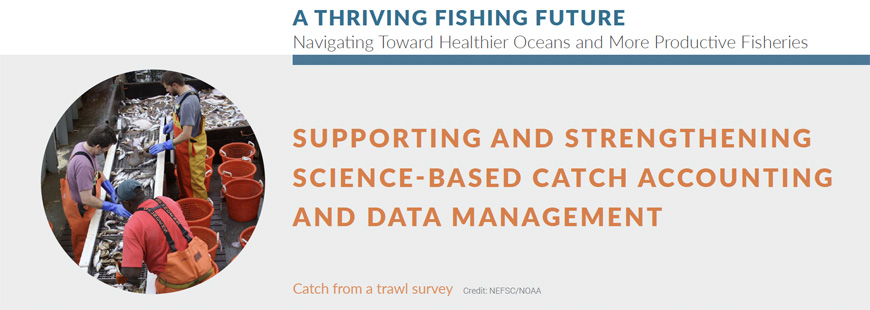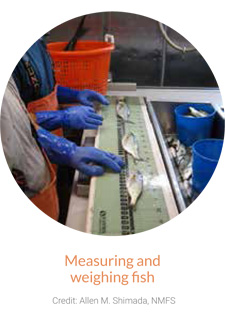Accurate, timely, and verifiable stock assessments are the foundation and hallmark of successful, science-based fishery management. A stock assessment is the primary tool for determining how many and what type of fish are believed to be in the water, and it enables fishery managers to set appropriate and effective catch limits for populations and the ecosystem. The quality and frequency of stock assessments, however, vary by region. Some U.S. fisheries are annually surveyed with state of the art assessment strategies; in other regions, the assessment process is underfunded or narrowly focused on major target species, leaving other species at risk.
Accurate assessments require reliable accounting of the species and amount of fish caught, and they need timely data on discards, landings, and fishery-independent state and federal scientific stock surveys. Deficits in any of these areas compromise the nation’s ability to manage our marine resources well, and thereby to achieve sustainable and predictable fisheries and healthy marine ecosystems.
Access to timely and accurate data on retained and discarded catch also varies by region. Human observer coverage is highly inconsistent in various fisheries around the country, with some having very low observer coverage. Although these fisheries produce data that purport to account for all catch, it is widely believed that the data are inaccurate for the catch on unobserved trips.
Collecting adequate catch data requires sufficient funding. Many fishermen, particularly small boat operators, cannot afford the rising costs of federal observers. Costs for current human observer programs run by the federal government have skyrocketed. Some fishermen pay for observers while others look to Washington for subsidies. As a result those who can afford observers have excellent, timely data available for catch accounting and stock assessments, while others have poor and unreliable data.
The Network’s Position
The Network believes that improving science-based assessments, catch accounting, and data management are essential to achieving healthier oceans and more productive fisheries.
Stock assessments: All major commercial and recreational fisheries should be managed with timely and accurate stock assessments designed to assess both target and non-target fish in the fishery. Full benchmark assessments of all directed fisheries should be conducted at least every five years. Stocks subject to overfishing or in an overfished condition should have annual assessments. All regional fishery management councils, which manage U.S. federal fisheries, should have protocols supporting rapid assessments in situations where there are new data on a stock that could significantly affect quotas.
Catch monitoring and accounting: Accurate, timely, and verified catch data should be secured from all major fisheries, both commercial and recreational, through a combination of available technologies, including logbooks, at-sea monitoring, and dockside sampling. Catch monitoring must be cost effective, designed to meet scientific needs and reduce scientific uncertainties, scaled appropriately to the resource impact of the fishery, and compatible with fleet capacity and vessel size. Increased use of third-party contractors should be allowed because they have proven effective in gaining industry support while reducing program costs and improving data timeliness.
NOAA Fisheries and the regional councils must move beyond pilot projects for electronic monitoring (EM) to full implementation in fisheries where at-sea monitoring by human observers is required. Properly designed, installed, and maintained, such systems provide an accurate and timely accounting of fish removals without the safety and operational challenges of human observers that many small boat operations cannot accommodate or afford.
Congress needs to develop consistent standardized criteria for funding at-sea monitoring programs and provide adequate annual appropriations accordingly. Under the current system, high-performing fisheries pay the costs of human observers and at-sea monitoring out of pocket, while other fisheries object to paying for observers or electronic monitoring and receive government subsidies.
Congress also needs to direct NOAA to develop a plan to replace its survey fleet. The periodic fishery-independent data it provides is essential to the continued success of the U.S fisheries program, but vessels will need to be replaced in the next 10 years.
Data processing and management: All data used for stock assessments, with controls to ensure that proprietary fishing information is protected, should be readily accessible for external reviews by qualified scientists. In addition, there should be a comprehensive external audit of NOAA Fisheries data management systems to determine consistency with best practices and to make recommendations for improvements and opportunities for increased efficiencies, including the creation of a national data management and catch accounting system. Furthermore, Congress should require NOAA and other government agencies, such as the U.S. Fish and Wildlife Service, to share relevant data that could help improve the accuracy of all models.
Funding: NOAA’s stock assessment capability, catch monitoring, data processing, and other essential fisheries research require a consistent and dedicated funding source to ensure continuity and robust analysis. These important activities and the data they produce form the core of sustainable fisheries management.
Recommendations and Actions
- Fully fund comprehensive and regular stock assessments in all regions, with an objective of full assessments of all directed fisheries at least every five years and annual assessments for all stocks that are overfished or subject to overfishing.
- Congress should direct NOAA Fisheries to achieve full EM implementation in New England and Alaska within two years of enactment of new legislation and in all other observed fisheries within five years of new legislation unless the fishery is found to be incompatible with EM.
- Commission an independent audit by technology and data management experts to review data management associated with stock assessment and catch accounting systems across all regions to ensure the best possible data is available on a timely basis to managers, fishermen, and the public.
- Expand catch monitoring to include recreational and commercial fisheries.
- Allow the use of third-party contractors to improve cost efficiency of catch observation and at-sea monitoring programs.
- Develop a fair and equitable cost distribution system to fully fund at-sea monitoring.
- Examine the current management of funds under the Saltonstall-Kennedy Act to ensure that they are used as required by statute, namely “to address the needs of fishing communities, optimize economic benefits by building and maintaining sustainable fisheries, and increase other opportunities to keep working waterfronts viable.”



